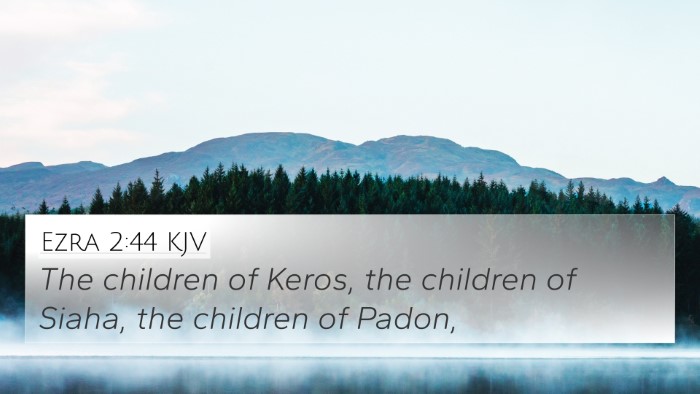Understanding Nehemiah 7:47
Nehemiah 7:47 recounts the names of the priests, the Levites, and the chief of the people that returned to Jerusalem after their exile. This verse plays a critical role in understanding the strength of communal identity and the continuation of worship practices among the returning exiles. Here, we delve into a comprehensive analysis of this verse, utilizing insights from Matthew Henry, Albert Barnes, and Adam Clarke, blending their perspectives for a more holistic interpretation.
Summary of Nehemiah 7:47
This verse lists the names of the returning priests and Levites who played an essential role in restoring the worship of Yahweh in Jerusalem. It illustrates both the significance of lineage and the continuity of religious practices that defined the returned community.
Key Themes and Concepts
- The Importance of Priestly Lineage: Matthew Henry emphasizes the significance of priestly lineage and how it contributes to the spiritual integrity of the returning community.
- Restoration of Worship: Albert Barnes highlights how this return was essential for reinstating the temple worship, which had been disrupted during the Babylonian exile.
- Community Identity: Adam Clarke notes the role these individuals played in preserving the Jewish identity and culture through their worship practices.
Interpretations from Public Domain Commentaries
Matthew Henry's Commentary
Henry points out the clarity this list provides regarding God’s faithfulness to His covenant. The returning priests and Levites signify that worship would be restored, bringing hope to the community who had endured hardship. Each name in this list reflects the providence of God in their lives, ensuring the continuity of worship.
Albert Barnes' Notes
Barnes elaborates on the implications of having precisely named individuals. The emphasis on names indicates the legitimacy and authority of the leaders in the newly restored Jewish community. This restoration was critical, as it re-established their spiritual practices and cultural heritage.
Adam Clarke's Commentary
Clarke draws attention to the necessity of these individuals in establishing the governance and spiritual authority needed among the exiles. The priests and Levites were vital for facilitating the sacrifices and conducting the services required by the Torah.
Cross-References with Nehemiah 7:47
To gain a deeper understanding of Nehemiah 7:47 and its implications, we can explore several related Bible verses:
- Ezra 2:2: A similar list of the returning exiles that reinforces the importance of the priests and Levites.
- Nehemiah 12:1-26: Details further the establishment of the priestly orders and the significance of names.
- Exodus 28:1: Discusses the ordination of Aaron and his sons, emphasizing the priestly lineage.
- 1 Chronicles 6:31-38: A genealogy of Levites that connects back to those who returned from exile.
- Deuteronomy 10:8: Talks about the priests being set apart to minister before God.
- Haggai 1:14: Emphasizes God stirring up the spirit of the priests during the restoration process.
- Zechariah 3:1-10: Describes the vision of Joshua the high priest, relevant to the priestly roles during the return.
Thematic Connections and Interpretive Insights
This verse not only lists names but signifies a theological theme of restoration—a significant narrative in the context of God’s covenantal faithfulness. The connections outlined here illustrate how vital these returning priests and Levites were in the community’s spiritual revival.
Use of Bible Cross-Referencing
Cross-referencing helps deepen our understanding of Biblical themes and promotes richer interpretations. For those seeking tools for Bible cross-referencing, these methods allow for fruitful study:
- Bible Concordance: Utilize a concordance to find instances of Levites and priests throughout the Scripture.
- Cross-reference Bible Study: Engage in studies that connect various passages discussing the roles of priests in worship.
- Comprehensive Bible Reference Resources: Seek out study guides that collate scriptures focused on worship practices.
- Bible Cross-reference Guide: Implement guides that provide insights into similar themes across both testaments.
Conclusion
Nehemiah 7:47 serves as a crucial verse in understanding the restoration of worship after exile. The restoration of priestly roles emphasized the continuity of God’s covenant with Israel and the community’s identity. By employing cross-referencing and comparative analysis of related verses, deeper theological insights can be drawn to elucidate the rich narrative of returning exiles and the establishment of worship in a renewed Jerusalem.
In summary, this verse, alongside its related cross-references, demonstrates a significant moment in Israel’s history where worship, identity, and God’s faithfulness intertwine, providing many insights for both individual study and communal worship.



